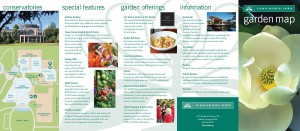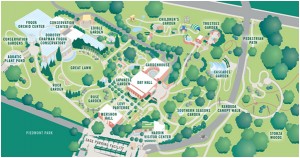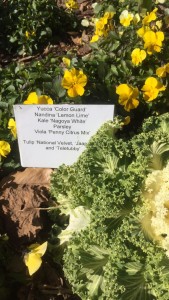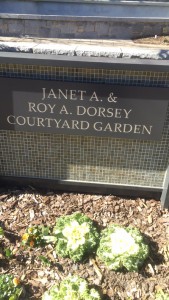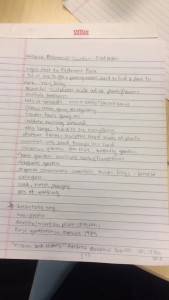This is an image of one of the brochures available at the Atlanta Botanical Garden. It gives information on the garden and the things offered there such as the café, gift shop, classes given, events offered, and school field trips that are available. This was one of multiple brochures available to visitors for free, giving them more knowledge of the workings of the garden.
Monthly Archives: February 2016
Digital record: signage
Digital record: Image
Digital Records: Image
Digital Records: Signage
Digital Records: Field Notes
Exterior Built Environment Description
As I pass Piedmont Park and pull into the entrance of the Atlanta Botanical Garden, I feel as if I have been transported into the middle of the woods. As I wait in line to receive my parking ticket, I notice that I am surrounded by various massive trees and plants. After getting my ticket, I drive through several levels of parking decks until I finally find a space to park in. I then proceed to wait in line to buy a ticket into the garden. I have only been in the garden for five minutes and already it seems very busy, especially for a weekday. Walking through the garden that has been here since 1985, I see tons of beautifully kept plants and flowers (Mission and History). Most of the flowers and plants exhibited have nameplates to specify what species they are. Many of the exhibits and sculptures are also named after people, probably because of donations made by those people to the garden. The garden has a special exhibit set up for the month of February that showcases an abundance of orchids. The orchids are bright purple and give off a strong unfamiliar scent. Walking through the garden using the map they provided, I see an herb and vegetable garden which showcase an array of dark greens and both give off smells which remind me of my mother’s kitchen in the summer. The tropical conservatory I entered next makes me feel as if I am in the jungle. The noise level is very high with waterfalls, birds, and frogs all making noise at the same time. One of my favorite things I found in the garden is the Mother Earth sculpture. It is a beautiful sculpture of a woman’s head made out of plants. Out of her hand runs water into a beautiful pond. Another one of my favorite places in the garden was the children exhibit. The exhibit had a bee hive showcasing bees buzzing while creating their habitat, a butterfly garden where butterflies fluttered around until landing on certain flowers, and multiple cute sculptures, like brightly colored gnomes, that catered to the younger visitors. While I was visiting the garden, I saw multiple advertisements for classes held there, such as gardening and drawing classes. Overall, the Atlanta Botanical Garden was very pretty and well organized, although it was quite expensive, busy, and I got tired from all the walking that was involved. Because it was winter, everything was a bit dreary, but in the spring and summer I bet the garden is just breathtaking with vibrant colors from everything blooming. I probably wouldn’t visit again as just a visitor, but would love to go to one of the private events occasionally held there.
“Mission and History.” Atlanta Botanical Garden. Web. 10 Feb. 2016.
Annotated Bibliography 3
Poister, Theodore H. “Transit-Related Crime In Suburban Areas.” Journal of Urban Affairs 18.1 (1996): 63-75. Web.
“Transit-Related Crime in Suburban Areas” was written by professor of Public Administration at Georgia State University, Dr. Theodore Poister. This journal discusses the relationship between high crime rates and public transportation. Looking at Atlanta’s MARTA, research showed crime to initially increase, but was followed by a decrease in crime rates. Still, the fear of increasing crime because of public transportation continues to prevent the extension of public transit rail lines, preventing economic expansion and growth in cities. Because there was no strong correlation between expanding public transit and crime rates increasing, it is likely that there are other factors that influence the rise of crime rates, concluding that the data found in Poister’s research cannot be used to blame public transit directly for higher crime rates. This journal entry debunks the myth that public transportation in downtown Atlanta and surrounding areas increases the crime rate. This source aids in better understanding the history of public transportation and it’s role in shaping the city of Atlanta. In “Architectural Exclusion: Discrimination and Segregation through Physical Design of the Built Environment”, transportation was listed as a method of architectural exclusion used to aid in segregation. This journal gives additional information on public transportation to help gain a larger understanding on the subject. This journal is well put together, but it is very inconclusive. There is no strong, solid data to back up the accusations and possible theories mentioned in the article. To make this journal a strong piece of evidence in an analysis, Poister needs to gather more data. This article adds information to the subject of segregation in Atlanta, as public transit was historically used to help segregate, as well as explaining how different aspects of the city, such as transportation, help shape Atlanta.
http://onlinelibrary.wiley.com/doi/10.1111/j.1467-9906.1996.tb00366.x/epdf
Annotated Bibliography 2
Newman, Harvey K. “Race and the Tourist Bubble in Downtown Atlanta.” Urban Affairs Review 37.3 (2002): 301-21. Web.
“Race and the Tourist Bubble in Downtown Atlanta” was written by Harvey K. Newman, a retired professor in the Andrew Young School of Policy Studies at Georgia State University. This journal explains the evolution of downtown Atlanta from a central business district to a popular tourist destination. This piece examines the multiple projects put in motion to bring in more visitors and stimulate the economy, a majority of which uprooted historically black areas in order to make room for more attractions. In “Architectural Exclusion: Discrimination and Segregation through Physical Design of the Built Environment” the author explains different methods of using environmental factors as segregation tools. This journal goes into more detail on how certain methods, such as building highways, are used to block access of certain places to particular groups of people. This article is very well written and credible, but it mainly only focuses on the pro-tourism side of the city’s history. To make this piece more well-rounded, additional arguments on the cons of developing for tourism could have been included. While this article explains where and when racial segregation took place, the previous bibliography, “Chocolate City, Vanilla Suburbs” examines what causes this segregation.
Annotated Bibliography 1
Reynolds Farley, Howard Schuman, Suzanne Bianchi, Diane Colasanto, and Shirley Hatchett. “Chocolate City, Vanilla Suburbs: Will the Trend toward Racially Separate Communities Continue?” Social Science Research 7.4 (1978): 319-44. Web.
In “Chocolate City, Vanilla Suburbs”, investigators for the 1976 Detroit Area Study of the University of Michigan began intensive research to fully understand the residential segregation in the city of Detroit. Their research concluded that while blacks prefer to live in a neighborhood with a mixture of people with black and white descent, whites are not as accepting of integration into their neighborhoods. Similar to Detroit, many of Atlanta’s neighborhoods are predominately all black or all white. The cause of this segregation is likely similar to the reasons the DAS investigators revealed while studying the Detroit residential segregation. I chose to use this article because it offers a closer look into the detail of certain segregation caused by the environment and why it is caused. This article is very well written and is unbiased in its research methods. One weakness of this journal is that the investigators looked exclusively at Detroit while conducting their research, ignoring all other cities in the United States. Their theories on segregation may not hold true when applied in other cities across the country. This journal is similar to “Race and the Tourist Bubble in Downtown Atlanta”, in that both works examine racism and segregation to a certain degree. This piece looks more in depth at what causes the segregation, while the other journal examines how segregation affects the development of Atlanta.
http://ac.els-cdn.com/0049089X78900170/1-s2.0-0049089X78900170-main.pdf?_tid=a0b81e76-cbaa-11e5-ac0d-00000aab0f02&acdnat=1454637120_33380cc393c22be14a3d39

